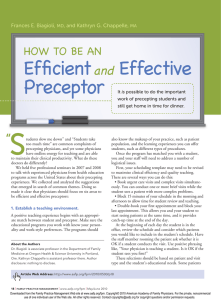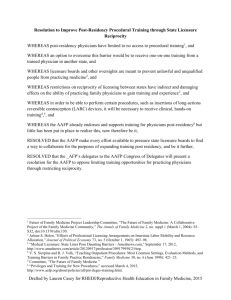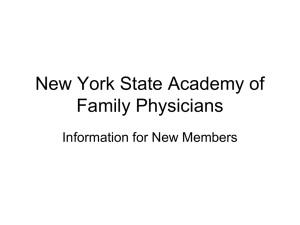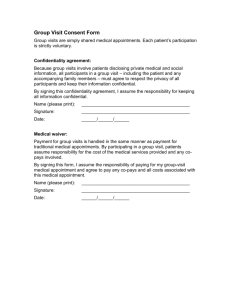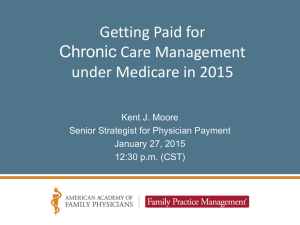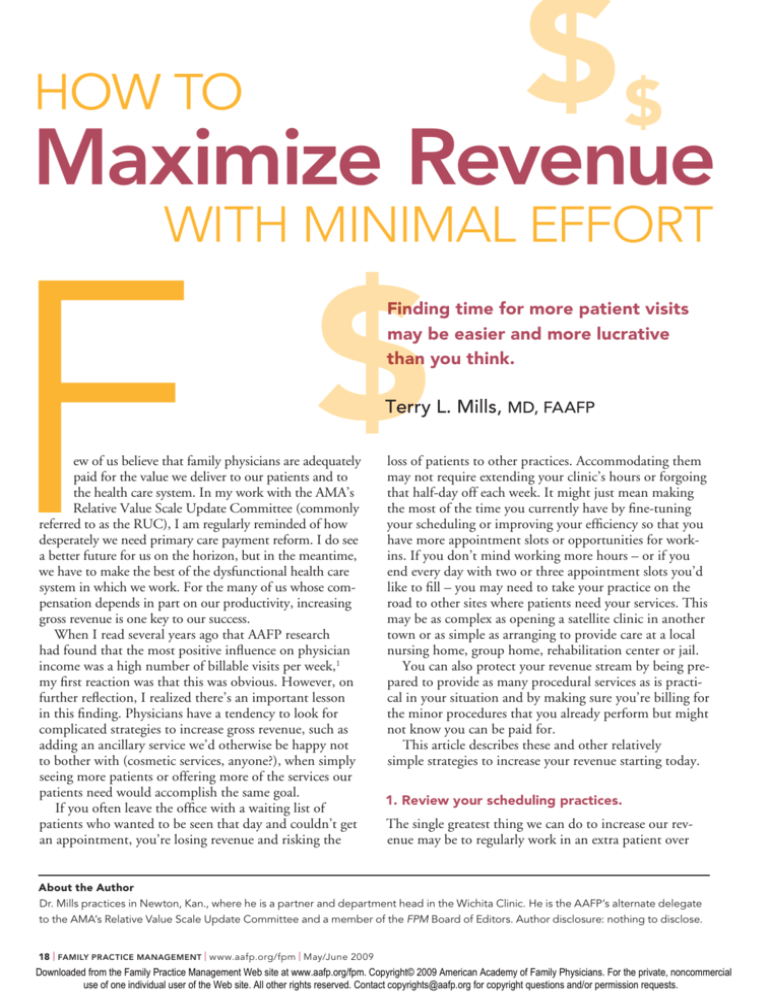
How to
Maximize Revenue
With Minimal Effort
F
ew of us believe that family physicians are adequately
paid for the value we deliver to our patients and to
the health care system. In my work with the AMA’s
Relative Value Scale Update Committee (commonly
referred to as the RUC), I am regularly reminded of how
desperately we need primary care payment reform. I do see
a better future for us on the horizon, but in the meantime,
we have to make the best of the dysfunctional health care
system in which we work. For the many of us whose compensation depends in part on our productivity, increasing
gross revenue is one key to our success.
When I read several years ago that AAFP research
had found that the most positive influence on physician
income was a high number of billable visits per week,1
my first reaction was that this was obvious. However, on
further reflection, I realized there’s an important lesson
in this finding. Physicians have a tendency to look for
complicated strategies to increase gross revenue, such as
adding an ancillary service we’d otherwise be happy not
to bother with (cosmetic services, anyone?), when simply
seeing more patients or offering more of the services our
patients need would accomplish the same goal.
If you often leave the office with a waiting list of
patients who wanted to be seen that day and couldn’t get
an appointment, you’re losing revenue and risking the
Finding time for more patient visits
may be easier and more lucrative
than you think.
Terry L. Mills, MD, FAAFP
loss of patients to other practices. Accommodating them
may not require extending your clinic’s hours or forgoing
that half-day off each week. It might just mean making
the most of the time you currently have by fine-tuning
your scheduling or improving your efficiency so that you
have more appointment slots or opportunities for workins. If you don’t mind working more hours – or if you
end every day with two or three appointment slots you’d
like to fill – you may need to take your practice on the
road to other sites where patients need your services. This
may be as complex as opening a satellite clinic in another
town or as simple as arranging to provide care at a local
nursing home, group home, rehabilitation center or jail.
You can also protect your revenue stream by being prepared to provide as many procedural services as is practical in your situation and by making sure you’re billing for
the minor procedures that you already perform but might
not know you can be paid for.
This article describes these and other relatively
simple strategies to increase your revenue starting today.
1. Review your scheduling practices.
The single greatest thing we can do to increase our revenue may be to regularly work in an extra patient over
About the Author
Dr. Mills practices in Newton, Kan., where he is a partner and department head in the Wichita Clinic. He is the AAFP’s alternate delegate
to the AMA’s Relative Value Scale Update Committee and a member of the FPM Board of Editors. Author disclosure: nothing to disclose.
18 | FAMILY PRACTICE MANAGEMENT | www.aafp.org/fpm | May/June 2009
Downloaded from the Family Practice Management Web site at www.aafp.org/fpm. Copyright© 2009 American Academy of Family Physicians. For the private, noncommercial
use of one individual user of the Web site. All other rights reserved. Contact copyrights@aafp.org for copyright questions and/or permission requests.
s t eve ske lto n
the lunch hour or at the end of the day. The path to a
healthier bottom line may be as straightforward as this.
Additionally, you may need to fine-tune the way your
appointments are scheduled. If appointments are booked
in standard 15-minute increments, you might be spending more time waiting for patients than you should. Or
if appointments are all booked at the top of the hour
(i.e., wave scheduling), your patients might be spending
more time waiting for you than they should. I’ve found
a “modified-wave” schedule to be the most efficient
approach for my practice.
A modified-wave template schedules two 15-minute
appointments on the hour, one appointment 15 minutes
later and another appointment 30
minutes after the hour. Typically there
is no appointment at 45 minutes after
the hour, which allows time for a 30minute appointment, an extra work-in
patient, or time to return phone calls
or catch up on documentation. A
modified-wave template also helps to
ensure that you’re not behind schedule
even before you begin. If you start seeing patients at 9 a.m. and one doesn’t
arrive on time, chances are the other
patient with a 9 a.m. appointment will.
You should also consider whether
your scheduler is getting the right visit
type – or the right patient – in the
right appointment slot. For example,
diabetes checks may not require 30
minutes, especially if you have systems
in place to ensure that lab results are
available in the chart at the time of the
visit. And certain patients will invariably consume the time of two appointments; book them accordingly. You
can optimize your scheduling procedures by enabling easy communication
between your scheduler and your clinical staff, for example, by putting their
desks close to one another.
Open-access, also known as
advanced-access or same-day, scheduling has emerged as a popular approach
in the last 10 years. The list of FPM
articles on page 20 includes one that
explains the benefits of this method
and how to implement it, as well as
articles that describe other concepts
mentioned here.
If your schedule is serving your practice well, your best
option may be to focus on improving your efficiency.
2. Work smarter.
Improving efficiency is truly a game of inches. There are
lots of ways to do it, and none are likely to result in dramatic gains, but if together they enable you to see two additional patients a day, the effort can amount to a tremendous
increase in revenue (see the estimate on page 21). According
to the research referenced earlier, high-earning physicians
work an average of 56 hours a week, and low-earning physicians work 51 hours a week. But the high-earners provide
Article Web Address: http://www.aafp.org/fpm/20090500/18howt.html
May/June 2009 | www.aafp.org/fpm | FAMILY PRACTICE MANAGEMENT | 19
Physicians have a tendency to
look for complicated strategies
to increase gross revenue.
The surest way to
increase revenue
is to see more
patients.
Working in an extra
patient each day
can make a big
difference in your
income over the
course of a year.
A modified wave
schedule can help
you start on time
and stay on time,
and create more
opportunities for
work-ins in the
process.
38 more visits per week than their low-earning
counterparts (high-earners provide a mean
number of 122 visits per week; low-earners provide 84). The high-earners aren’t just working
harder; they’re working smarter. These techniques can help you to do the same:
Have a huddle. Starting each morning
with a 10-minute meeting of key clinical and
office staff members can save you valuable
time later. The purpose of a huddle is to look
at the day’s schedule, anticipate information needs or special circumstances that may
arise during the day and plan accordingly to
prevent slow downs. Check that lab results,
reports from other physicians, discharge
paperwork and so on are in the chart. Identify
patient visits that might take more time than
scheduled, and make adjustments. Talk with
your scheduler about times when you might
be able to see an extra patient.
Negotiate an agenda for the visit. This
technique can be very helpful when patients
arrive with lists, and even more helpful when
they don’t. We handle this informally in my
practice. As the medical assistant is rooming
the patient and taking vital signs, she asks,
“Why are you here today?” and documents
the patient’s responses in the record. When
necessary, I work with the patient to prioritize
the list and plan our time effectively. Some
practices take a more formal approach and ask
patients to write on a tear-off pad or white
board the things they want their doctor to
address during the visit. This can help patients
to focus and prevent “Oh, by the way” issues
from surfacing late in the visit, and it can help
doctors to see up front whether negotiation
and prioritization are needed. (Note: The article on page 23 outlines a process for managing
encounters with patients who bring lists.)
Don’t leave the exam room during a visit.
I can be most productive when I don’t have to
leave the exam room to obtain
information or supplies that I
need. By stocking exam rooms
FPM articles on practice efficiency
appropriately and implement“Huddles: Improve Office Efficiency in Mere Minutes.”
ing daily huddles as described
Stewart EE, Johnson BC. June 2007; http://www.aafp.org/
earlier, you can avoid interrupfpm/20070600/27hudd.html.
tions during patient visits. If
10 times a day you leave the
“Ideas for Optimizing Your Nursing Staff.“ Weymier RE.
exam room for two minutes
February 2003; http://www.aafp.org/fpm/20030200/
to fetch a form or an instru51idea.html.
ment that you need, you’ve
“Same-Day Appointments: Exploding the Access Parasquandered the equivalent of
digm.“ Murray M, Tantau C. September 2000; http://www.
an entire patient visit. Think
aafp.org/fpm/20000900/45same.html.
about using your nursing staff
“Seven Reasons to Dictate in the Presence of Your Patients.“
to deliver to the patient any
Teichman PG. September 2001; http://www.aafp.org/fpm/
prescriptions, drug samples,
20010900/37seve.html.
patient education materials or
other
items that couldn’t have
“Strategies for Better Patient Flow and Cycle Time.“ Backer
been
identified
in advance so
LA. June 2002; http://www.aafp.org/fpm/20020600/
that
you
can
move
on to your
45stra.html.
next patient.
“Tuning Up Your Patient Schedule.“ Chung MK. January
2002; http://www.aafp.org/fpm/20020100/41tuni.html.
20 | FAMILY PRACTICE MANAGEMENT | www.aafp.org/fpm | May/June 2009
Delegate work that
doesn’t require a physician’s
license. Don’t spend time on
Revenue tips
patient-care-related tasks that don’t require
a medical degree. For perspective, it can be
helpful to ask yourself whether you would pay
another doctor to do the same thing. Delegate
as many administrative tasks as you can while
still maintaining a good understanding of
your practice’s operations.
Dictate in the patient’s presence. This
takes some getting used to, and it may not be
appropriate in every case, but dictating notes
while you’re still in the exam room with the
patient can improve your efficiency. Your
memory is fresh, and details are clear. Dictating in the patient’s presence is also a good way
of validating the patient’s concerns, cementing
your treatment alliance with the patient and
reiterating your instructions.
Avoid batching your work. Dictating in
the patient’s presence is a good example of
the kind of continuous flow process that you
should strive for throughout your day. I try to
dictate after every visit or two, instead of batching the dictation for a large number of visits at
the end of the day. I actually used a stopwatch
and timed myself for a week; I found that my
average dictation took more than 50 percent
longer when I did it at the end of the day.
Streamline your message traffic. Work
closely with your nursing staff to try to
minimize the number of times an individual
request must change hands before a definitive
answer is reached. This may involve establishing protocols to help ensure that your staff
gathers all the information you need to make
a decision before they pass along the message.
Protocols that enable them to act on their
own or with minimal input from you, as often
as their license and skill level will allow, can
also improve efficiency dramatically. Rather
than dealing with phone messages and refill
requests at lunch or the end of the day, try to
deal with them between patient visits.
3. Keep multiple revenue streams,
including procedures.
It’s important to realize the extent to which
your scope of practice drives your revenue
stream and to carefully weigh decisions that
would narrow it. Whether it’s performing a
certain office procedure, seeing nursing home
patients, doing obstetrics or taking care of
patients in the hospital, think of each service
as a tributary to your practice’s revenue stream.
The value of two extra visits
21,600
$
10 additional visits per week for 48 weeks; $45 per visit average
Give up one of these services and you’re cutting off part of your revenue stream, one that
can be difficult to reclaim, particularly once
procedural skills or privileges have lapsed.
My advice is to do every procedure you
can comfortably and confidently perform in
your setting. I did give up obstetrics, but I do
almost every procedure you can imagine a
family physician doing: skin procedures, joint
aspirations and injections, trigger point injections, tendon and tendon sheath injections,
simple- and moderate-complexity fracture care,
treadmill stress tests and an array of hospital
procedures. This scope wouldn’t make sense
in every practice, but it does work for mine. If
you do procedures that your colleagues don’t,
invite them to refer their patients to you. The
family physicians I practice with on occasion
refer their patients to me for simple fracture
care, pulmonary function test interpretation and joint injections rather than to the
subspecialists in our multispecialty group; I
return the favor with referrals for vasectomies.
Another reason to maintain your procedural
skills is that procedures pay better than the
evaluation and management (E/M) services
you’re likely to replace them with (see the
table on page 22).
The following are examples of office procedures you might already be doing but not
billing for. Although not all of my payers
reimburse for these services (some bundle
them with the related E/M service), I include
them on our superbill and always bill for
them. Don’t get caught up in keeping track of
exactly which payer covers which procedures
this year; payment policies and coverage decisions change frequently enough that it’s almost
impossible to keep up. I encourage my partners
to provide outstanding patient care, document
everything they did and bill for everything they
documented. This process will at least position
you to receive the best payment you can, when
you can. The only theoretical downside is an
You can create
more opportunities
to see patients by
practicing more
efficiently.
Huddles, agendasetting and avoiding interruptions
during the visit
can improve your
productivity.
Delegating work
that doesn’t require
your skills, dictating in the patient’s
presence, not
“batching” work and
implementing protocols for message
traffic can also help
to create capacity
for more visits.
May/June 2009 | www.aafp.org/fpm | FAMILY PRACTICE MANAGEMENT | 21
The single greatest thing we can
do to increase our revenue may be to
regularly work in an extra patient over
the lunch hour or at the end of the day.
If you have excess
capacity, you can
fill it by contracting
with other facilities
where your services
might be needed,
such as nursing
homes, psychiatric
facilities and jails.
A broad scope
of service that
includes multiple
procedures can
help ensure high
demand and plenty
of patient visits.
Procedural services
pay better than
cognitive services,
so incorporating them in your
practice will help
your bottom line
as well as provide
your patients with
convenient, comprehensive care.
increase in charge-offs, or a potentially larger
gap between gross and net charges. Of course
payment amounts vary; the ones listed below
are based on the 2009 Medicare fee schedule,
not geographically adjusted, and they have
been rounded to the nearest dollar:
• 90465, Immunization administration
younger than 8 years of age (includes percutaneous, intradermal, subcutaneous or intramuscular injections) when the physician counsels
the patient/family; first injection (single or
combination vaccine/toxoid), per day; $21,
• 92567, Tympanometry (impedance testing); $18,
• 92552, Pure tone audiometry (threshold),
air only; $21,
• 94150, Vital capacity, total (separate procedure); $18,
• 94664, Demonstration and/or evaluation
of patient utilization of an aerosol generator,
nebulizer, metered dose inhaler or IPPB device;
$15 (I provide this service to patients for whom
I’m prescribing an inhaler for the first time),
• 96110, Developmental testing, limited
(e.g., Developmental Screening Test II or
Early Language Milestone Screen), with interpretation and report; $13 (I do this testing as
part of well-child visits),
• 46600, Anoscopy, diagnostic, with or
without collection of specimen(s) by brushing
or washing (separate procedure); $72.
The bottom line
I’d be remiss if I failed to acknowledge that
revenue is only part of the net income equation.
A dollar of expense saved is every bit as good
as a dollar of gross revenue earned. All practices should go over their expenses, both fixed
and variable, with a fine-tooth comb. When
combined with the additional revenue that the
suggestions in this article can help to produce,
some well-chosen cuts will make an even bigger
difference in your bottom line.
Send comments to fpmedit@aafp.org.
1. Carter J. What makes a high-earning family physician?
Fam Pract Manag. July/August 2005:16-20. Available
at: http://www.aafp.org/fpm/20050700/16what.html.
Accessed March 23, 2009.
procedures pay more
The cognitive services that account for the majority of many family physicians’ billings often take
more time and pay significantly less than procedural services.
Work RVUs
(relative value
units)
Payment1
99214, Office or other outpatient visit for the evaluation and
management of a new patient
1.42
$92.33
54150, Circumcision, using clamp or other device with regional
dorsal penile or ring block
1.9
CPT code, descriptor
$172.76
20610, Arthrocentesis, aspiration and/or injection; major joint
or bursa (e.g., shoulder, hip, knee joint or subacromial bursa)
.79
$69.97
11400, Excision, benign lesion including margins, trunk, arms
or legs; excised diameter 0.5 cm or less
.87
$102.43
1. 2009 Medicare fee schedule, not geographically adjusted. Payment amounts reflect RVUs for malpractice and practice expenses as well.
22 | FAMILY PRACTICE MANAGEMENT | www.aafp.org/fpm | May/June 2009

